Table of Contents
IntroductionKarate Kata
Matsubayashi-Ryu Masters Matsubayashi-Ryu kata Kata sources and usageMasters and Methods
Training - Yasutune Itosu Technique - Chojun Miyagi Principles - Kenwa Mabuni Fighting - Choki MotubuAnatomy
Musculature Skeleton Nervous System MeridiansBooks and Reference
Book of 5 Rings Art of War Tai Chi Classics Mind Body UnificationPhilosophy
Ten Bulls Tao Te ChingZen Buddhism
History Zazen Zazen Yojinki Zen Koans Zen Stories Zen DialoguesConcepts and Glossary
Selected GlossaryTen Bulls
Introducing 'Ten Bulls' by Kakuan
The enlightenment for which Zen aims, for which Zen exists, comes of itself. As consciousness, one moment it does not exist, the next it does. But physical man walks in the element of time even as he walks in mud, dragging his feet and his true nature. So even Zen must compromise and recognize progressive steps of awareness leading closer to the ever instant of enlightenment.
In the twelfth century the Chinese master Kakuan drew the pictures of the ten bulls, basing them on earlier Taoist bulls, and wrote the comments in prose and verse translated here. His version was pure Zen, going deeper than earlier versions, which had ended with the nothingness of the eighth picture. It has been a constant source of inspiration to students ever since, and many illustrations of Kakuan's bulls have been made through the centuries.
The illustrations reproduced here are modern versions by the noted Kyoto woodblock artist Tomikichiro Tokuriki.
1.The Search for the Bull
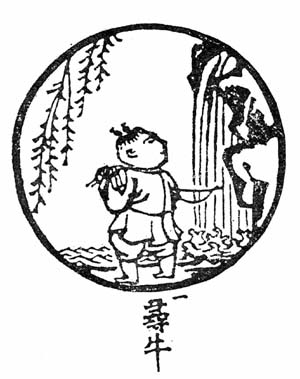
In the pasture of this world, I endlessly push aside the tall grasses in search of the bull.
Following unnamed rivers, lost upon the interpenetrating paths of distant mountains,
My strength failing and my vitality exhausted, I cannot find the bull.
I only hear the locusts chirring through the forest at night.
2. Discovering the Footprints
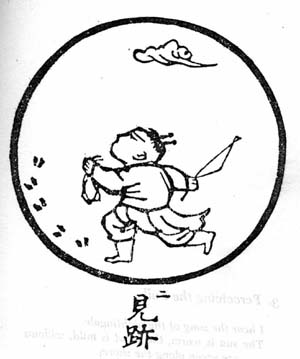
Along the riverbank under the trees, I discover footprints!
Even under the fragrant grass I see his prints.
Deep in remote mountains they are found.
These traces no more can be hidden than one's nose, looking heavenward.
3. Perceiving the Bull
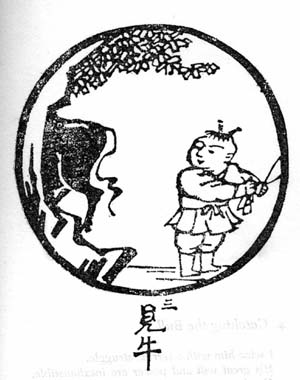
I hear the song of the nightingale.
The sun is warm, the wind is mild, willows are green along the shore,
Here no bull can hide!
What artist can draw that massive head, those majestic horns?
4. Catching the Bull
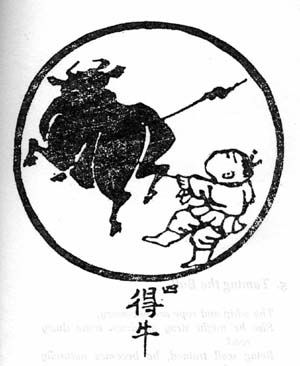
I seize him with a terrific struggle.
His great will and power are inexhaustible.
He charges to the high plateau far above the cloud-mists,
Or in an impenetrable ravine he stands.
5. Taming the Bull
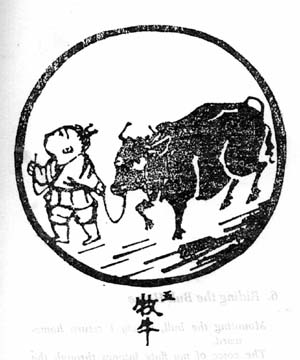
The whip and rope are necessary,
Else he might stray off down some dusty road.
Being well trained, he becomes naturally gentle.
Then, unfettered, he obeys his master.
6. Riding the Bull Home
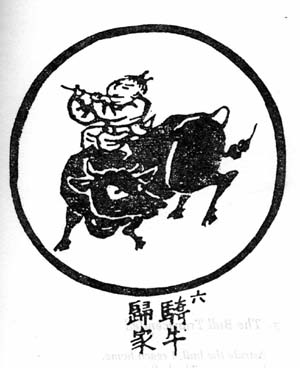
Mounting the bull, slowly I return homeward.
The voice of my flute intones through the evening.
Measuring with hand-beats the pulsating harmony, I direct the endless rhythm.
Whoever hears this melody will join me.
7. The Bull Transcended
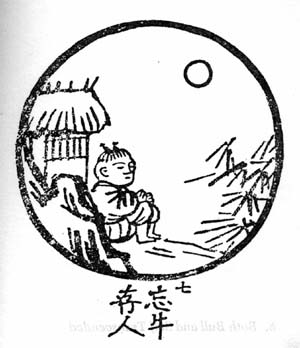
Astride the Bull, I reach home.
I am serene. The bull too can rest.
The dawn has come. In blissful repose,
Within my thatched dwelling I have abandoned the whip and rope.
8. Both Bull and Self Transcended
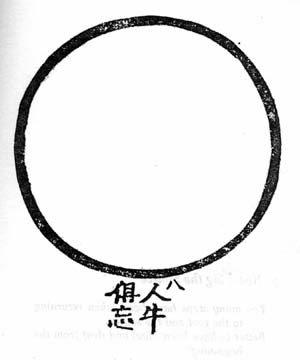
Whip, rope, person, and bull--all merge in No-Thing.
This heaven is so vast no message can stain it.
How may a snowflake exist in a raging fire?
Here are the footprints of the patriarchs.
9. Reaching the Source

Too many steps have been taken returning to the root and the source.
Better to have been blind and deaf from the beginning!
Dwelling in one's true abode, unconcerned with that without.
The river flows tranquilly on and the flowers are red.
10. In the World
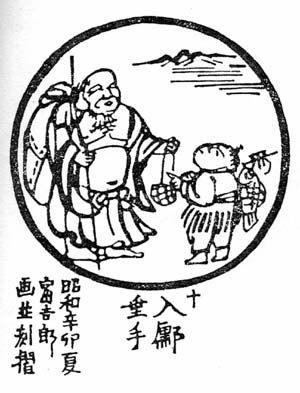
Barefooted and naked of breast, I mingle with the people of the world.
My clothes are ragged and dust-laden, and I am ever blissful.
I use no magic to extend my life;
Now, before me, the dead trees become alive.
Living Karate - Sydney Matsubayashi Ryu